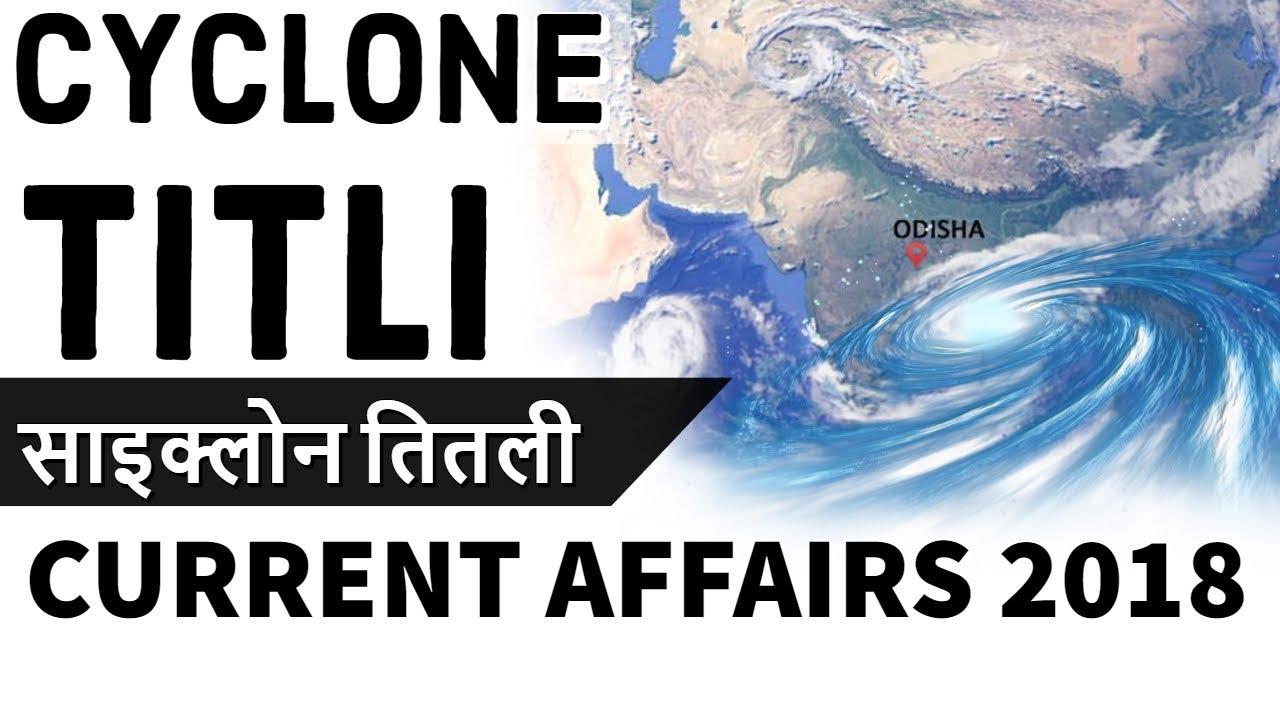Table of Contents
CYCLONES
– OCTOBER 2018 Arabian Sea and Bay of Bengal cyclones on course to intensify Cyclonic storm ‘TITLI’ has hit the Bay of Bengal and another cyclonic storm ‘LUBAN’ has hit the Arabian sea.
HOW WILL THIS IMPACT ODISHA?
- The state government of Odisha has geared up to face the situation setting a target of “zero casualty.” • The Odisha government today began immediate evacuation of people in five coastal districts of Ganjam, Puri, Khurda, Kendrapara and Jagtsinghpur.
- National Disaster Response Force (NDRF) and Orissa Disaster Rapid Action Force (ODRAF) personnel have already been positioned in vulnerable districts.
CYCLONES IN THE PAST
- In October 1999, the deadliest of cyclones, ‘Super Cyclone’ hit the coast of Odisha with a wind speed of 300 kmph disrupting the lives of 20 million in Odisha. It led to the loss of 15,000 lives and Rs 6,243.96 crore in revenue.
- In 2013, Cyclone ‘Phailin’ made landfall in the coastal Odisha with a wind speed of 185 kmph, and was considered as the second deadliest cyclone that had hit the eastern state with hardly any casualties.
CATEGORIES OF CYCLONES
- Category 1: Wind and gales of 90-125 kph, negligible house damage, some damage to trees and crops. • Category 2: Destructive winds of 125-164 kph. Minor house damage, significant damage to trees, crops and vehicles, risk of power failure.
- Category 3: Very destructive winds of 165-224 kph. Some roof and structural damage, some caravans destroyed, power failure likely.
- Category 4: Very destructive winds of 225-279 kph. Significant roofing loss and structural damage, vehicles blown away, widespread power failures.
- Category 5: Very destructive winds gusts of more than 280 kph. Extremely dangerous with widespread destruction.
WHY THIS CYCLONE IS NAMED ‘TITLI’?
Cyclone Titli got its name from Pakistan. Eight countries in the North Indian Ocean region — Bangladesh, India, Maldives, Myanmar, Oman, Pakistan, Sri Lanka and Thailand — have contributed a set of names which are assigned sequentially for whenever a cyclonic storm develops. They came up with a list of 64 names — eight names from each country — for upcoming cyclones. The World Meteorological Organisation (WMO), a Geneva-based agency of the United Nations (UN), maintains the lists of given names
HOW ARE CYCLONES NAMED?
- In September 2004, an international panel on tropical cyclones decided that countries from the region would each put in names, which would be assigned to storms in the Bay of Bengal and Arabian Sea.
- Eight countries — India, Pakistan, Bangladesh, Maldives, Myanmar, Oman, Sri Lanka and Thailand – participated and came up with a list of 64 names.
- In the event of a storm, the Regional Specialized Meteorological Centre, New Delhi, selects a name from the list.
WHY IT IS NECESSARY TO NAME CYCLONES?
- Tropical cyclones are named to provide easy communication between forecasters and the general public regarding forecasts, watches, and warnings.
GUIDELINES FOR NAMING CYCLONES
Citizens can submit names to the Director General of Meteorology, IMD, for consideration, but the weather agency has strict rules for the selection process.
- A name, for instance, ‘should be short and readily understood when broadcast’.
- The names must also be neutral, ‘not culturally sensitive and not convey some unintended and potentially inflammatory meaning’.
- Furthermore, on the account of the ‘death and destruction’ a storm in the Indian Ocean causes, their names are retired after use, unlike those in the Atlantic and Eastern Pacific lists, which are reused every few years.
NOT WITHOUT CONTROVERSY
- Cyclone Mahasen, which hit in 2013 and was named by Sri Lanka, was changed to Viyaru after protests by nationalists and officials in Sri Lanka.
- They said Mahasen was a king who had brought peace and prosperity to the island, and it was wrong to name a calamity after him.
WHAT’S THE DIFFERENCE BETWEEN HURRICANES, CYCLONES AND TYPHOONS?
- Hurricanes, cyclones and typhoons are all tropical storms. They are all the same thing but are given different names depending on where they appear. When they reach populated areas they usually bring very strong wind and rain which can cause a lot of damage.
- Hurricanes are tropical storms that form over the North Atlantic Ocean and Northeast Pacific. Cyclones are formed over the South Pacific and Indian Ocean. Typhoons are formed over the Northwest Pacific Ocean.


























 WhatsApp
WhatsApp